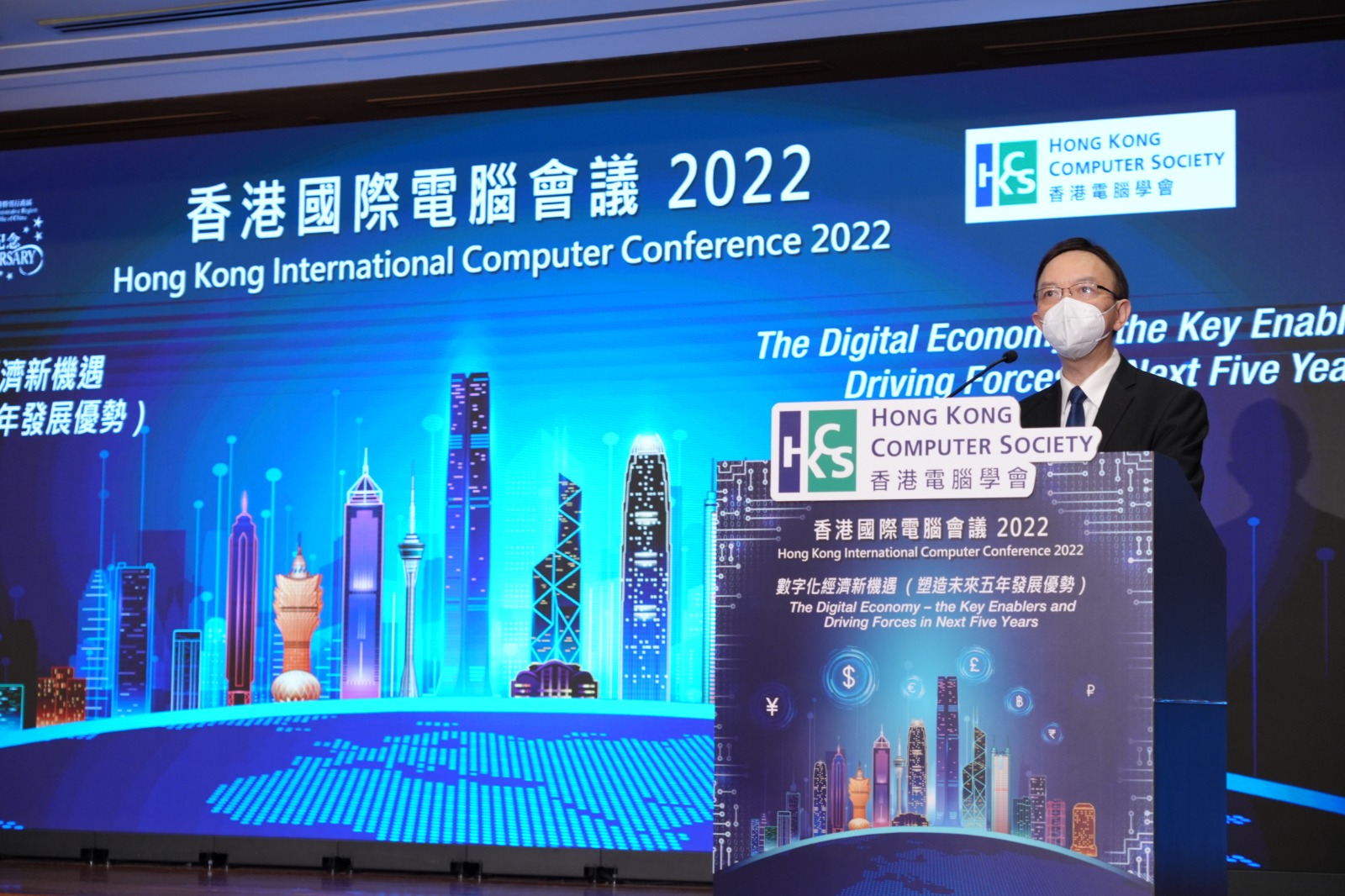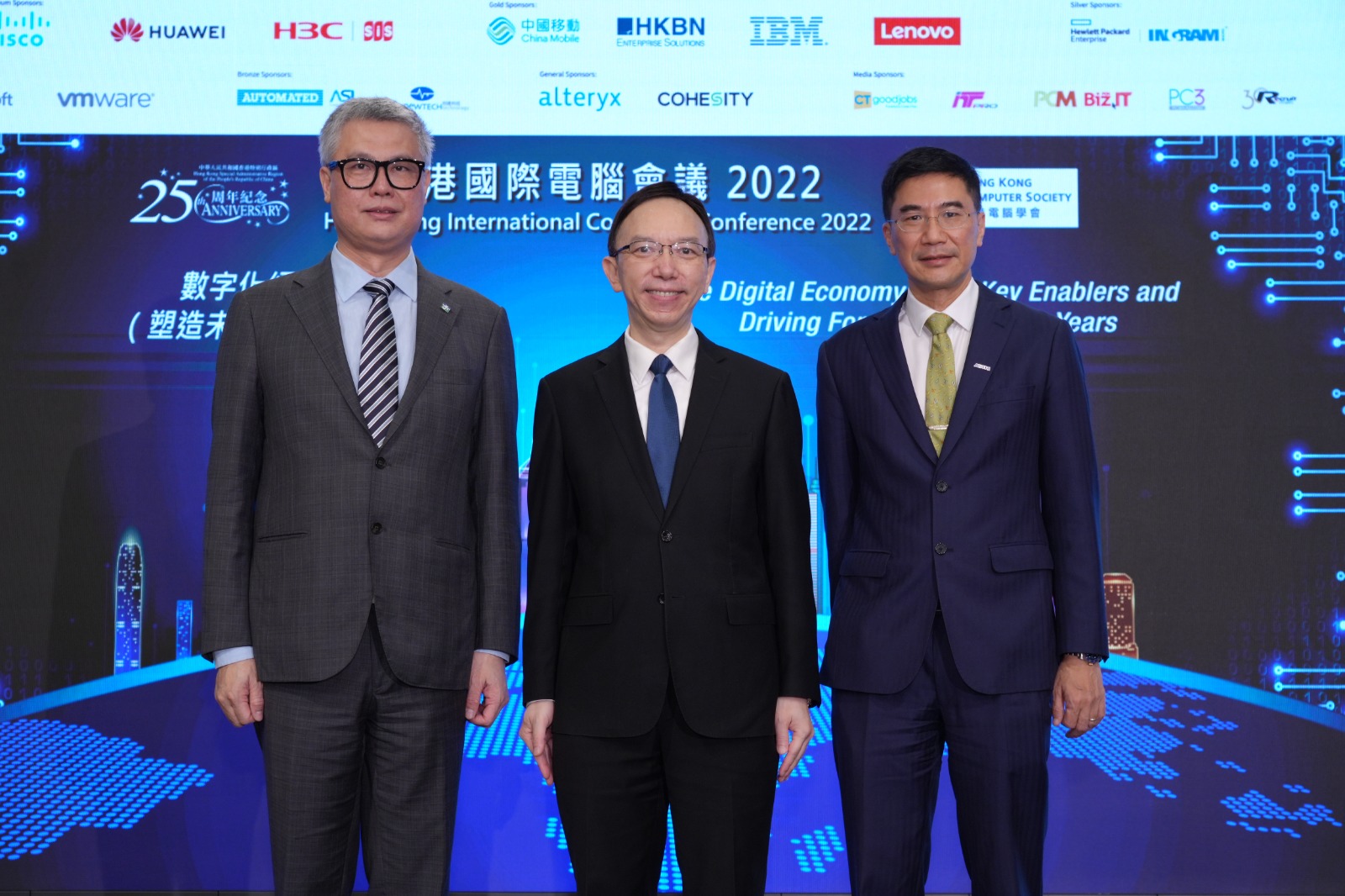Opening Remarks by Mr. Victor Lam, JP, Government Chief Information Officer, at the “Hong Kong International Computer Conference (HKICC) 2022 Day 2 Morning Session - Digital Infrastructure” (with photos)
Rocky (President, Hong Kong Computer Society, Dr. Rocky CHENG), Denis (Chairperson of Conference Committee of HKICC 2022, Dr. Denis YIP), Herbert (Programme Chairperson of HKICC 2022, Professor Herbert CHIA, Venture Partner, Sequoia Capital China), Colin (Executive Director (Financial Infrastructure), Hong Kong Monetary Authority, Mr. Colin LAU), Professor GUO (Provost-designate, The Hong Kong University of Science and Technology, Professor GUO Yi ke), distinguished speakers, honorable guests, ladies and gentlemen,
Good morning! I have great pleasure to join you at the Hong Kong International Computer Conference (HKICC) today. As one of the most prestige and time-honored ICT events in Hong Kong, the HKICC is a perfect occasion for our professionals and business leaders from local and abroad to share and exchange their insights on the latest trends of ICT innovations and developments, as well as the challenges and opportunities ahead.
Digitalisation has now become increasingly prominent in all walks of life. We have to expedite and increase our investment in digital infrastructure, which is essential to digital economy and smart city development. At the same time, the vast opportunities brought about by the rapid advancement in telecommunications and cloud computing are redefining the components of our digital infrastructure.
Hong Kong is privileged to have the most advanced telecommunications infrastructure in the world which provides innovative, diversified and affordable services. As at September 2022, Hong Kong has around 300 Internet Services Providers offering broadband services and achieving a household penetration rate of 99.3%. The quality of Hong Kong’s Internet services is one of the best in the world. With its fast and stable connection, our Internet services cover almost every part of the territory at a cost which is amongst the lowest in the world, securing Hong Kong’s position as an Internet hub of the region. At the same time, the coverage of local commercial 5G services has already exceeded 90% of the territories, including 99% of our major business districts. Our world-class telecommunications infrastructure, enabled by a pro-competition policy and a host of facilitation measures, lays a solid foundation for Hong Kong to accelerate digitalisation and excel in its development into a competitive digital economy.
The Government has spared no efforts over the years in putting in place digital infrastructures to accelerate digital transformation of public services, improve operational efficiency and enhance user experience. For instance, we launched the Government Cloud Infrastructure Services (GCIS) in September 2020. Equipped with agile application development tools, GCIS provides a reliable and scalable IT platform that facilitates government departments to develop and deliver digital services in a rapid, secure and agile manner. So far, GCIS has supported over 380 digital government applications. We have also implemented the Big Data Analytics Platform and the “Digital Highway”, which support big data analytics and high-speed data transmission, allowing data interchange and real-time data sharing among departments. We further launched a shared Blockchain Platform in June this year for departments to develop more blockchain applications. Another upcoming new shared infrastructure is a “Chatbot-as-a-Service” platform, with ready-to-use building blocks such as natural language processing engine and knowledge base, to facilitate departments to develop new chatbots easily and efficiently.
To enable the public to use government online services more conveniently and safely, we launched a digital identity infrastructure, “iAM Smart”, in December 2020. Currently, over 220 online services of the Government, public and private organisations are accessible through “iAM Smart” and the number of registered users has exceeded 1.6 million. As announced by the Chief Executive in his recent Policy Address, we will drive the full adoption of “iAM Smart” by 2025, enhancing user experience and achieving a “single portal for online government services”.
As regards the financial infrastructure, the Hong Kong Monetary Authority (HKMA) recently launched the Commercial Data Interchange (CDI). It seeks to enable financial institutions, with the consent of enterprises, especially small and medium enterprises, to obtain commercial data for conducting more accurate credit analysis, thereby facilitating them to utilise their own data to receive more convenient and effective financing services. We will also launch a Consented Data Exchange Gateway by end of 2023, allowing the public to authorise the exchange of their personal data amongst government departments by means of data interchange through computer systems, thereby saving the trouble of providing personal particulars to different departments. It will also connect to the CDI of the HKMA to enable real-time data interchange and sharing between financial institutions and government departments.
A more recent and exciting development in the Fintech area is the issuance in end-October a policy statement on the development of Virtual Assets in Hong Kong. This statement sets out the Government’s policy stance and approach towards developing a vibrant sector and ecosystem for virtual assets in Hong Kong. We fully recognise the potential of DLT and Web 3.0 alike to become the future of finance and commerce, and the Government is prepared to embrace this future under proper regulation to promote the sustainable development of financial services across the whole virtual asset value chain. I am sure my HKMA colleague Colin will share with you more insights on this exciting development shortly.
Data centre is the backbone of digital infrastructure underlying the development of digital economy. Apart from the existing concessionary measures of encouraging conversion of industrial buildings for use as data centres and development of high-tier data centres on industry lots, we are actively exploring the development of cavern data centres for effective use of land resources. Indeed, caverns have lots of benefits as data centre, including excellent physical security, stable operating environment, energy saving due to lower temperature, and releasing the surface land for other beneficial uses. The Government will lead by example and start the technical feasibility on the setting up of a new government data centre in a cavern.
As for enriching the ingredients for data analytics, we will continue to actively open up data and encourage public and private organisations to follow suit for innovative industry applications. We will also explore with the Mainland authorities the arrangements for the flow of data from the Mainland to Hong Kong, with a view to jointly promoting the co-ordinated development of smart cities in the Greater Bay Area. Furthermore, recognising that easily accessible, high quality, standardised and up-to-date geospatial data and service can greatly facilitate the development of various smart city applications, we will open up the Common Spatial Data Infrastructure portal by end of this year, together with more than 500 spatial datasets for free use by the public to promote more innovative applications on geospatial data.
All in all, we will strive to further enhance our digital infrastructure to contribute our part in realising Hong Kong’s vision of becoming an International I&T Centre.
I wish the Conference every success, and all of you a fruitful exchange today. Thank you!
- ENDS -





